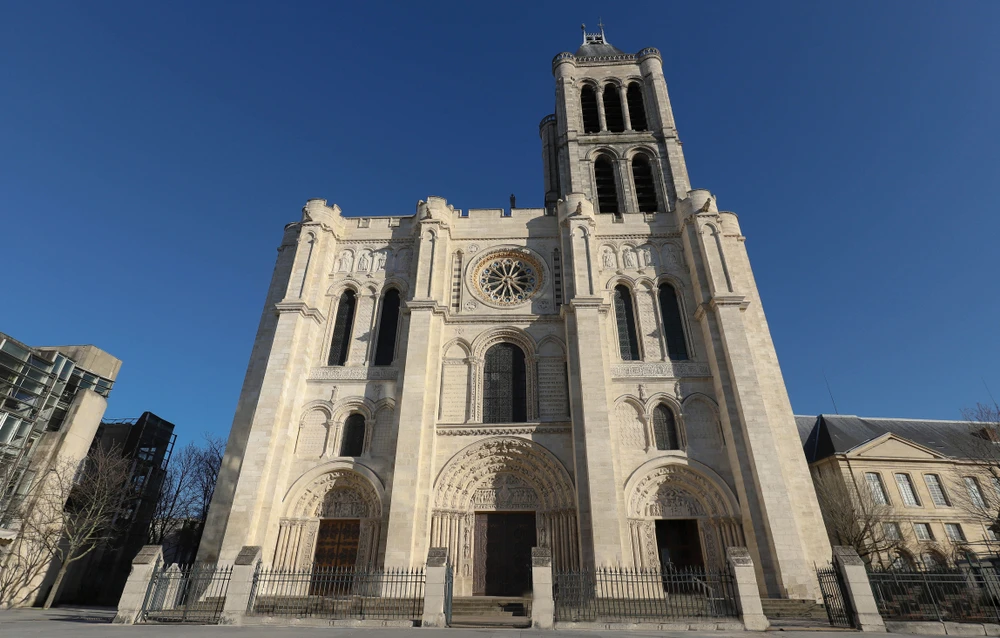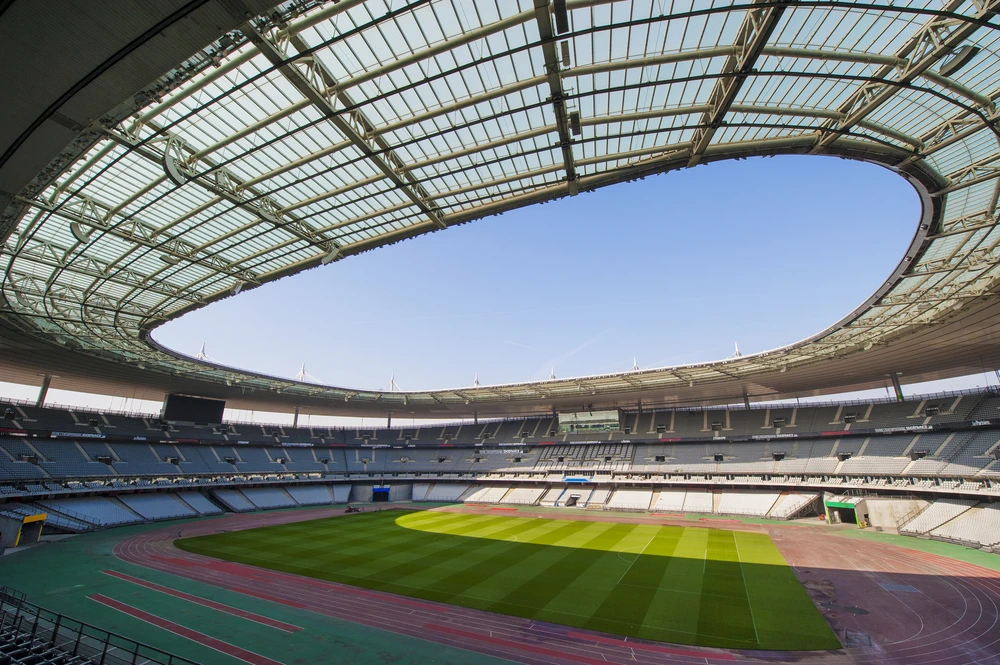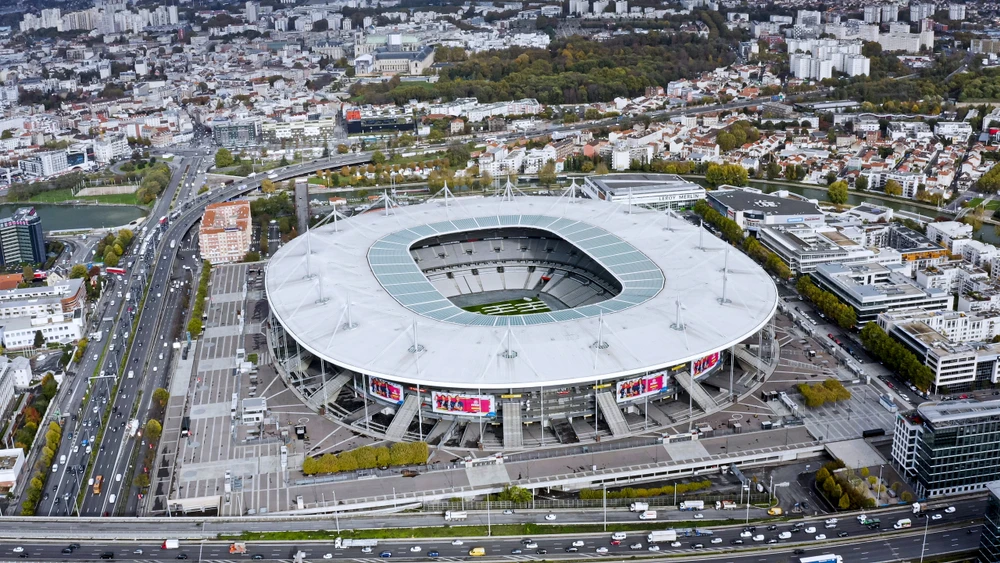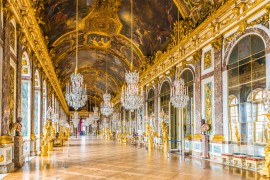A history of the Stade de France in Saint Denis
In Saint Denis, one of the oldest cities in France.
Even if the population of Saint Denis is young, Saint Denis, sub-prefecture of the department of Seine-Saint-Denis, Île-de-France region, has its roots in the time of the Gauls. The place was called Catolacus in the 2nd century AD and it was an important trading site for the Parisii tribe whose capital was Lutetia on what is now the Ile de la Cité in Paris.
Saint Denis, by Jean Bourdichon / Horae ad usum Parisiensem, c. 1480, Bibliothèque Nationale de France. Photo chosen by Monsieurdefrance.fr
The city is named after Saint Denis, the first bishop of Paris, a Christian martyr, whose legend tells us that his head was cut off in Paris, at Montmartre (the mount of martyrs) and that he took his head in his hand before walking to Saint Denis where he collapsed. A certain Catulla would then have buried Saint Denis in her field. A mausoleum would have been built there afterwards. If you want to tell it to you at work: as he took his head in his hands after the decapitation Saint Denis is a cephalophore saint.
The city of the basilica necropolis of the kings of France.

The royal basilica of Saint Denis. Photo chosen by Monsieurdefrance.com : Petr Kovalenkov/Shutterstock
Important merchant city, Saint Denis also developed a lot at the same time as the Royal Abbey of Saint Denis, cherished by the kings of France who made it their tomb. All the Capetian kings were buried there for 1000 years. The queens of France were crowned there, as the kings were in Reims. They are 29 to have been crowned queens of France here, including the famous Anne of Brittany. Entirely emptied of their bodies during the sacking of Saint Denis in October 1793, during the French Revolution, many tombs are still in the basilica, saved by the abbot Gregoire in the name of their artistic interest. Denouncing their destruction by the revolutionaries at the tribune of the Assembly, the abbot invented the word "vandals" to denounce the destroyers of works of art.
The birth of the Stade de France

The laying of the roof of the Stade de France / Photo chosen by monsieurdefrance.com : By Gattwinkel - Own work, Public Domain / Wikipedia
For many years there was talk of building a larger stadium in or around Paris than the Parc des Princes, the capital's stadium. In 1988, when France was chosen to host the 1998 World Cup, it committed itself to building a large stadium worthy of the event. It is the first time since 1924 that the State commits itself to build a stadium. Most of the existing stadiums are due to the municipalities on which they are built. Several locations are proposed: Vincennes, Nanterre, Marne le Vallée (near Disneyland) but they were considered too far away by the Parisian elected officials who suspended their financial participation. In the end, the Plaine Saint Denis, closer to the capital, was chosen. A choice was made between two projects: one by Jean Nouvel, rectangular, and another more rounded project. The latter was chosen, signed by the architects Michel Macary, Aymeric Zublena, Michel Regembal and Claude Constantini. The first stone was laid on September 6, 1995.
An important building site
Nearly 2 years of work are necessary to build the stadium, which is not much considering the size of the site. 800,000 square meters were terraced and 180,000 cubic meters of concrete were poured. More than 40,000 different plans were produced for the construction teams, who were the first to use the stadium during an inaugural soccer match between the "stadium builders" and the Variety Club of France on November 19, 1997. The stadium of France is officially inaugurated by the president of the Republic Jacques Chirac on January 28th, 1998 with the match France Spain.
 The interior of the stadium of France in Saint Denis. Photo chosen by Monsieurdefrance.com : Yuri Turkov/Shutterstock
The interior of the stadium of France in Saint Denis. Photo chosen by Monsieurdefrance.com : Yuri Turkov/Shutterstock
The name "stade de France
Many proposals were made, and a consultation was even launched by a TV channel to choose the name of this new stadium. While his name was largely at the top of the consultation, Michel Platini refused that his name be attributed to the place. A committee finally chose "Stade de France", according to the proposal of artists Liane Foly and Francis Huster.
The Stade de France in figures

Aerial view of the Stade de France in Saint Denis. Photo chosen by Monsieurdefrance.Fr : PhotoLondonUK/Shutterstock
The Stade de France is the largest stadium... Of France. It is the 6th largest stadium in Europe. It measures 119 meters by 75 meters. It is 35 meters high but the roof is suspended 46 meters above the central lawn. It is equipped to host soccer and rugby matches as well as athletics championships. For sports events, it can hold from 75,000 people (for athletics) to 80,698 seats for a soccer or rugby match. For concerts, it can hold up to 100,000 people in a central stage configuration. Many concerts have been held at the Stade de France, from the Rolling Stones to David Guetta, including Muse, Mylène Farmer, Johnny Hallyday and the Red Hot Chili Peppers.
How to go to the Stade de France
Address :
Stade de France : Mail des aiguilles, 93200 Saint Denis.
GPS : Latitude : 48.918 / Longitude : 2.351
Nearest streets:
Gates A and B and Z: rue El Ouafi
Doors B to J: Avenue Jules Rimet
Gates K, L and N: rue Henri Delaunay
Doors N to Y: Avenue du Président Wilson.
By subway / Bus / Train
RER D : Stade de France Saint Denis station (15 minutes walk from the stadium entrance)
RER B : La Plaine Stade de France station (10 minutes walk from the stadium entrance)
Metro 12: Aubervilliers, Saint Denis, Front Populaire station.
By car :
via the A1 and A86 motorways.
A1 freeway
exit n°2 Stade de France
A86 freeway
exit n°9 Saint Denis - La Plaine Stade de France
Parking lots
The parking lots are almost all located along the quai du Général de Gaulle, Rue Jessie Owens and Rue El ouafi.
- Parking P1 for entrance at gates N, R, S, T, U, X, Y less than 2m10 high
- Parking P2 for the entrance in doors H, J, K, L, N, R less than 2m height
- Parking P3 for the entrance at doors Z, A, B, C, D, E, G, H, J, K - less than 2m10 high







